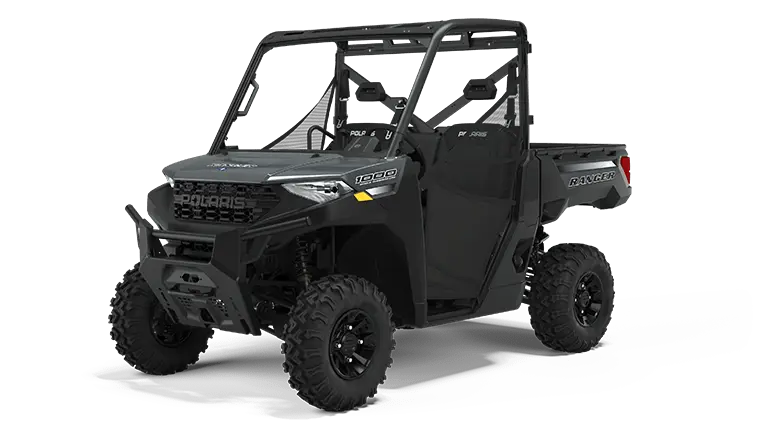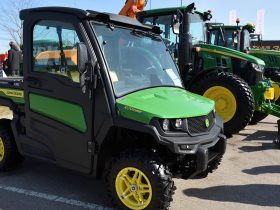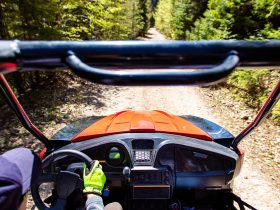Utility Task Vehicles or as they are often abbreviated or UTV is a great type of passenger vehicles that can be used to perform a variety of tasks such as transporting people and items along with large distances and distinct environments.
Many UTV’s are created to be used in a specific area such as in agriculture, used by the military, or for extreme environments such as snowy and icy environments or deserts for example. Additionally, in the past few decades, UTVs have been increasingly driven recreationally.
In this article, we are going to be taking a look at the Polaris Ranger and Kawasaki Mule UVTs which are two well known and respected model series in the UTV world.

The Polaris Ranger is manufactured by American manufacturer Polaris which has been in business for more than half a century and specializes in the manufacture of vehicles such as snowmobiles, cars, motorcycles, and of course UTVs among other types of vehicles.

While the Kawasaki Mule is manufactured by the Motorcycle & Engine division of the Kawasaki which is one of the biggest conglomerates in Japan that builds ships, cars, and trains. Read more about manufacturers from Japan, in our article Japanese Made UTVs.
Table of Contents
Polaris Ranger vs Kawasaki Mule Comparison
In this Polaris Ranger vs Kawasaki Mule article, we are going to be comparing all of the key aspects of these two model series in order to help you decide which is the best option for you and the purposes you are trying to use it for.
Size
Size is an important metric to keep into account as it the bigger that a UTV is, the more people it will be able to transport at the same time as well as hold more payload as well as tow extra payload at the back. However it also comes with its drawbacks, for example, a bigger vehicle will require more time to be spent on cleaning it. Furthermore, it will require more space in the location where it is going to be stored a sheltered, additionally, the bigger that the vehicle is the less mobile it is going to be which can be a problem in a rural environment where it can get stuck or not be able to complete a tight turn without causing damage to the environment or the vehicle itself.
Out of the two model series, the Polaris Ranger has the smaller vehicles, although this is slightly skewed by the fact that the Polaris Ranger has a Youth vehicle. This Youth model will not be able to accustom a fully grown adult so it will be out of the question for the majority of interested buyers. On average, the Kawasaki Mule product range is 25 cm bigger in width. Both of the biggest models of the two product ranges are able to host a maximum of four people safely.
Engine
The engine is what powers all vehicles, engines are one of the heaviest parts of any vehicle. This is why an important sign to look for when searching for a good engine is the so-called power to weight ratio, the higher this ratio is the better the engine is although with everything it should be in moderation in order to ensure adequate control and usability.
In the Polaris Ranger model series, the engine is located in the rear of the vehicle, this is done in order to limit the sound that the drivers and passengers are exposed to. Moreover, the Polaris Ranger line is well known for how easy it is to turn on using a twist switch that takes just a few seconds with the engine startup process not having any outages or random jerks but is instead a seamlessly smooth process.
Apart from that, there is a major difference between the types of engines used in the two UTV lines, in the Polaris Ranger a 4 stroke engine of a various number of cylinders is used while in the Kawasaki Mule vehicles you have OHV engines also known as Overhead Valve Engines. The engine of the Kawasaki Mule is more efficient because the way the engine in those vehicles is designed allows for the fuel to reach the combustion chamber much more easily and be spread inside more evenly.
Payload and Towing Capacity
One of the most simple but at the same time most important features of utility task vehicles. The payload and towing capacity does not take into account how many people are on board the vehicle at the time but instead, it is calculated based on the vehicle’s excess power after the vehicle’s person transportation capacity has been maxed out. Two major factors are at play that influences the total payload and towing capacity, the size of the storage facilities as well as the power of the vehicle. With the storage facilities playing a bigger role in the payload capacity which is stored onboard the vehicle and the power plays a bigger part in the towing capacity of the utility task vehicles.
The two product lines we have featured in this article are pretty even in this area, the Kawasaki Mule line has a maximum payload capacity of 1582 lbs compared to the max 1000 lbs of the biggest Polaris Ranger vehicle. This is likely a lot to do with the total size of the vehicles, with the Kawasaki Mule’s being much larger on average.
On the other hand, the Polaris Ranger has a towing capacity of 2500 lbs while the alternative from the Kawasaki product line maxes out at 2000 lbs. It is also important to note that the smallest models from both lines to not have a specified towing capacity so it is not recommended to tow anything if you purchase the smallest versions otherwise you risk damaging your vehicle.
Vehicle Suspension
A vehicle’s suspension is a complicated aspect that is down to a lot of different factors that all have to come into play for an optimum result, it is important as it makes it easier to control your vehicle when driving it and it also makes the ride a lot more enjoyable as the ride is less bumpy due to shock absorption. Another aspect of suspension is that it absorbs the shock from breaking on the passengers and also protecting the tires from getting damaged by keeping it firmly on the ground as much as possible.
The major improvement in the Polaris Ranger vehicle line is that the suspension has been made quieter allowing for a more enjoyable ride where you will not be interrupted or annoyed by the sound created by the spring and shock-absorbing system. This system stabilizes the vehicle when the road is uneven which is very likely since most of the time such vehicles are driven offroad.
Kawasaki Mule, the Japanese alternative, also has a high-quality suspension system in multiple areas of the vehicle. The suspension system is well-balanced to make sure that it absorbs any shock adequately while also not making the vehicle feel rigid when being driven. On every wheel of the UTVs from this company, there is a suspension system that is covered by a rubber casing. This provides extra stability to all sides of the vehicle and makes sure that no matter in what direction you happen to be driving that you will still be able to benefit from the high-quality suspension system of these vehicles.
Customizability
Although admittedly not the most essential feature that a person to look out for it is still something worth noting when you are weighing up all the factors during your decision-making process. Overall there is not much difference between the two product lines that we are reviewing in this Polaris Ranger vs Kawasaki Mule: Which Is Better article. For starters, both product lines have different sizes for their customers to choose from, such as two-seaters, three-seaters, and four-seaters. The four-seater category in the Polaris Ranger line is called ‘crew’, with only one vehicle in this category in the Polaris product line.
The major difference, however, is that in the Polaris Ranger line there is a Youth vehicle, which comes with unique features such as a password protected safe-start, a training DVD, and two helmets for kids. Currently, there is no special vehicle exclusively for children in the Kawasaki Mule line. Another difference is that with the Polaris Ranger there is a larger selection of colors and designs to choose from for your vehicle while with Kawasaki UTV’s you have just one basic color to choose from, which is timberline green. However, you should note that the non-default color or design options offered by the Polaris company are more expensive.
Extra Features
Everyone likes extra features regardless if they are buying a utility task vehicle or a toaster, however, there is a fine line between actually useful features and gimmicks that have been included for the sake of it without adding a lot of value to the customer. In this section, we are going to be taking a look at the extra features that both UTV lines have to offer and also assessing these actual features on whether they are actually useful.
On the Polaris Ranger vehicles, there is a seatbelt reminder light which is a very useful feature that will proportionally decrease the number of injuries that drivers and passengers of the vehicles. Life can be hectic and people can easily get distracted and forget to put on their seatbelt, so such a feature will make sure to remind them. Another feature of the Polaris Ranger is a trip meter which is a device and display that shows how long a certain trip took. This is a popular feature that is used by people that taking part in UTV racing, so it may not have a lot of use for farmers for example.
With the Kawasaki Mule, you have extra bright headlights which are great if you are going to be driving early the morning or at night when it is going to be dark. It will help reduce accidents and damage to your vehicle which in the long term will save you money. Another feature of this particular vehicle line is the way that the back of the vehicle can be converted into an extra storage place, this is done by essentially pushing down the back two seats thus extending the cargo bed.
When looking at the extra features it is important to evaluate which ones will be the most useful and valued by you and the other passengers and then make your decisions since the two-vehicle lines do not have the exact same list of extra features.
Affordability and Price
The affordability of an item is one of the most expensive things to consider for the overwhelming majority of consumers, especially with high-value items such as utility task vehicles. Technically the Polaris Ranger line has the cheapest vehicle at $5,544 plus indirect taxes, however, this is the Youth vehicle that is too small for a grown adult to use and is not able to transport or tow a heavy load.
After this factor has been highlighted and considered, it is in fact the Kawasaki Mule line that has the most affordable vehicle, with the Mule SX 4×4 costing around $9,000 compared to the $12,500 price tag associated with the cheapest model of the product line by Polaris. Additionally, the most expensive model of the Polaris Ranger line is around $5000 more expensive than the highest-priced vehicle in the Kawasaki vehicle line. The reason for this is most likely because Kawasaki is a much larger company than Polaris so it is able to bring its cost downs through economies of scale.
Warranty
In this area the vehicle lines from both companies are pretty equal, both companies offer 1-year warranties on their products. However, you only qualify for the warranties if the problems arise due to initial defects from the manufacturing of the product. These warranties will help protect you from any issues with the product that is the manufacturer’s fault.
Conclusion
In conclusion, both the Polaris Ranger and Kawasaki Mule utility task vehicles are two of the highest quality model series in this type of vehicle. Both are able to do a great job for a wide array of uses such as hunting, farming, and racing among many other uses. If you are working with a tight budget then the Kawasaki Mule line may be the best option for you, it has a much simpler design that comes in just one color. Furthermore, the Kawasaki brand UTV is made for working rather than for recreational use.
If you have the money to spare and are looking for a well-designed vehicle with a modern aesthetic than you should consider going for one of the vehicles from the Polaris Ranger vehicle line. UTVs from this line have a lot of extra features such as the ability to alternate the colors of your headlights between red and blue as well as a trip meter that measures the speed of a specified trip which is generally a feature used for racing. Furthermore, if you have a young child and you are interested in getting them a utility task vehicle then you have the option of the Youth model from the Polaris line that as noted above in this comes with two helmets for kids, instructions that teach you how to use the vehicle as well as safety features to give parents the peace of mind that they deserve.
But in order to pick the best option that is most suitable to you, you should choose a vehicle from the model series that has the most features that you will need for the tasks that you will use it for or if you are going to be using this video simply recreationally then which features you will find the most fun to use. Although there are major differences in the prices of the product ranges that we have featured in this Polaris Ranger vs Kawasaki Mule: Which Is Better article, you should look at your options as long-term investments that will be worth your money if you are going to be using them regularly in the long term.







